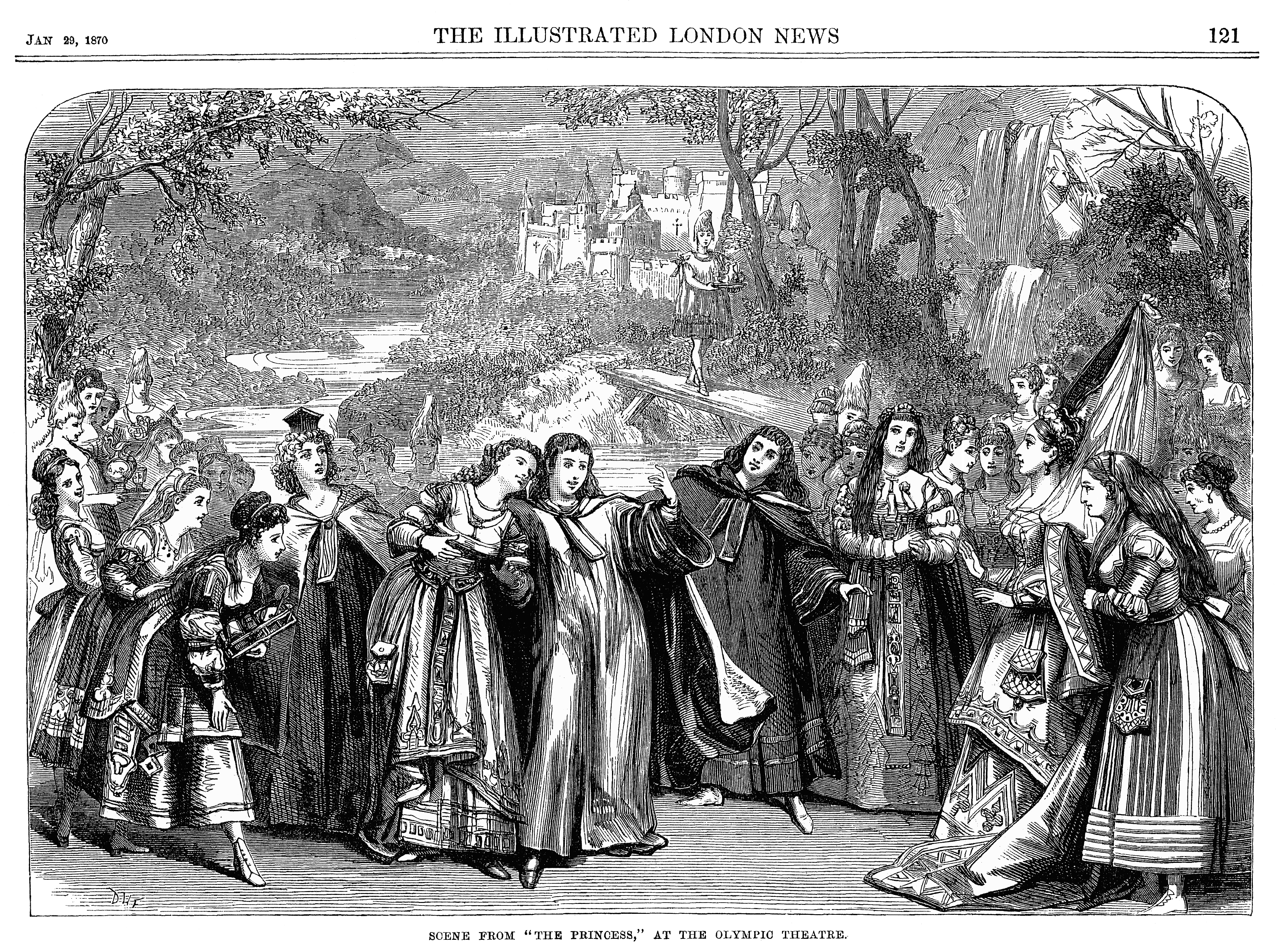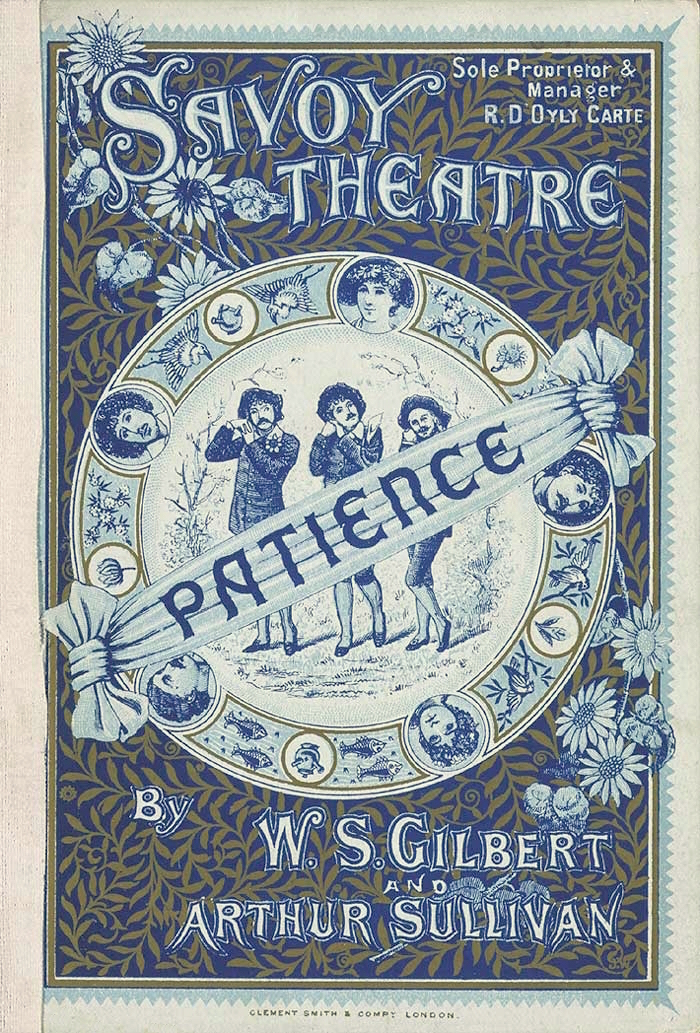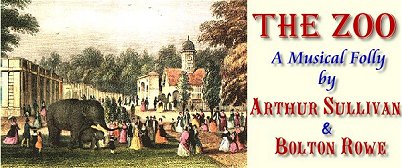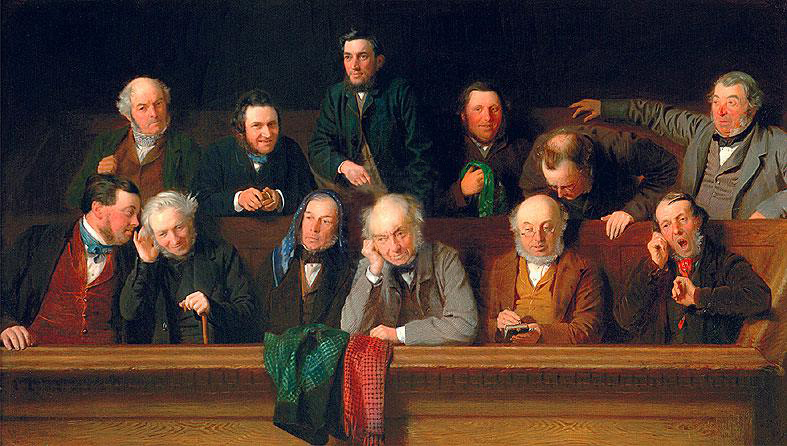|
Compositions By Arthur Sullivan
The following is a list of musical works by the English composer Arthur Sullivan, best known for his operatic collaborations with W. S. Gilbert. In all, Sullivan's artistic output included 23 operas, 13 major orchestral works, eight choral works and oratorios, two ballets, one song cycle, incidental music to several plays, numerous hymns and other church pieces, and a large body of songs, parlour ballads, part songs, carols, and piano and chamber pieces. Sullivan began to compose music at an early age. His first known composition, ''By the Waters of Babylon'', dates from when he was eight years old. While a member of the prestigious boys' choir of the Chapel Royal, with the support of the choirmaster, Thomas Helmore, Sullivan composed several more anthems, and one of these, ''O, Israel'', was Sullivan's first published composition, in 1855. Sullivan attended the Royal Academy of Music from 1856 to 1858 and the Leipzig Conservatoire in Germany from 1858 to 1861.Jacobs, pp. 17–2 ... [...More Info...] [...Related Items...] OR: [Wikipedia] [Google] [Baidu] |
Sir Arthur Seymour Sullivan
Sir Arthur Seymour Sullivan (13 May 1842 – 22 November 1900) was an English composer. He is best known for 14 comic opera, operatic Gilbert and Sullivan, collaborations with the dramatist W. S. Gilbert, including ''H.M.S. Pinafore'', ''The Pirates of Penzance'' and ''The Mikado''. His works include 24 operas, 11 major orchestral works, ten choral works and oratorios, two ballets, incidental music to several plays, and numerous church pieces, songs, and piano and chamber pieces. His hymns and songs include "Onward, Christian Soldiers" and "The Lost Chord". The son of a military bandmaster, Sullivan composed his first anthem at the age of eight and was later a soloist in the boys' choir of the Chapel Royal. In 1856, at 14, he was awarded the first Mendelssohn Scholarship by the Royal Academy of Music, which allowed him to study at the academy and then at the Felix Mendelssohn College of Music and Theatre, Leipzig Conservatoire in Germany. His graduation piece, inc ... [...More Info...] [...Related Items...] OR: [Wikipedia] [Google] [Baidu] |
The Sapphire Necklace
''The Sapphire Necklace, or the False Heiress'' (completed by 1867, and at least mostly completed by 1864), was the first opera composed by Arthur Sullivan. It was never performed, and most of the music and libretto are now lost. Background After his incidental music to '' The Tempest'' brought Arthur Sullivan early fame in 1862, he began to experiment with a wide variety of musical compositions. By 1864, the young Sullivan had written a ballet (''L'Île Enchantée''), orchestral pieces including ''The Masque at Kenilworth'', several hymns, a few piano solos, and some part songs and parlour ballads. He had also set to work on ''The Sapphire Necklace''. As with some of his other compositions in the 1860s, the libretto was provided by his friend Henry F. Chorley. However, this libretto proved particularly difficult to set. Later in life Sullivan would say that no other libretto had given him more difficulty, and an 1879 article suggests that he later decided to suppress the oper ... [...More Info...] [...Related Items...] OR: [Wikipedia] [Google] [Baidu] |
The Yeomen Of The Guard
''The Yeomen of the Guard; or, The Merryman and His Maid'', is a Savoy Opera, with music by Arthur Sullivan and libretto by W. S. Gilbert. It premiered at the Savoy Theatre on 3 October 1888 and ran for 423 performances. This was the eleventh collaboration of fourteen between Gilbert and Sullivan. The opera is set in the Tower of London during the 16th century, and is the darkest, and perhaps most emotionally engaging, of the Savoy Operas, ending with a broken-hearted main character and two very reluctant engagements, rather than the usual numerous marriages. The libretto does contain considerable humour, including a lot of pun-laden one-liners, but Gilbert's trademark satire and topsy-turvy plot complications are subdued in comparison with the other Gilbert and Sullivan operas. The dialogue, though in prose, is quasi-William Shakespeare, Shakespearean, or Early Modern English, early modern English, in style. Critics considered the score to be Sullivan's finest, including its ... [...More Info...] [...Related Items...] OR: [Wikipedia] [Google] [Baidu] |
Ruddigore
''Ruddigore; or, The Witch's Curse'', originally called ''Ruddygore'', is a comic opera in two acts, with music by Arthur Sullivan and libretto by W. S. Gilbert. It is one of the Savoy Operas and the tenth of fourteen comic operas written together by Gilbert and Sullivan. It was first performed by the D'Oyly Carte Opera Company at the Savoy Theatre in London on 22 January 1887. The first night was not altogether a success, as critics and the audience felt that ''Ruddygore'' (as it was originally spelled) did not measure up to its predecessor, '' The Mikado''. After some changes, including respelling the title, it achieved a run of 288 performances. The piece was profitable, and the reviews were not all bad. For instance, the ''Illustrated London News'' praised the work of both Gilbert and, especially, Sullivan: "Sir Arthur Sullivan has eminently succeeded alike in the expression of refined sentiment and comic humour. In the former respect, the charm of graceful melody pre ... [...More Info...] [...Related Items...] OR: [Wikipedia] [Google] [Baidu] |
The Mikado
''The Mikado; or, The Town of Titipu'' is a comic opera in two acts, with music by Arthur Sullivan and libretto by W. S. Gilbert, their ninth of fourteen Gilbert and Sullivan, operatic collaborations. It opened on 14 March 1885, in London, where it ran at the Savoy Theatre for 672 performances, the second-longest run for any work of musical theatre and one of the longest runs of any theatre piece up to that time.The longest-running piece of musical theatre was the operetta ''Les Cloches de Corneville'', which held the title until ''Dorothy (opera), Dorothy'' opened in 1886, which pushed ''The Mikado'' down to third place. By the end of 1885, it was estimated that, in Europe and America, at least 150 companies were producing the opera.H. L. Mencken, Mencken, H. L.]Article on ''The Mikado'', ''Baltimore Evening Sun'', 29 November 1910 ''The Mikado'' is the most internationally successful Savoy opera and has been especially popular with amateur and school productions. The work has ... [...More Info...] [...Related Items...] OR: [Wikipedia] [Google] [Baidu] |
Princess Ida
''Princess Ida; or, Castle Adamant'' is a comic opera with music by Arthur Sullivan and libretto by W. S. Gilbert. It was their eighth operatic collaboration of fourteen. ''Princess Ida'' opened at the Savoy Theatre on 5 January 1884, for a run of 246 performances. The piece concerns a princess who founds a women's university and teaches that women are superior to men and should rule in their stead. The prince to whom she had been married in infancy sneaks into the university, together with two friends, with the aim of collecting his bride. They disguise themselves as women students, but are discovered, and all soon face a literal war between the sexes. The opera satirizes feminism, women's college, women's education and Charles Darwin, Darwinian evolution, which were controversial topics in conservative Victorian era, Victorian England. ''Princess Ida'' is based on a narrative poem by Alfred, Lord Tennyson called ''The Princess (Tennyson poem), The Princess'' (1847), and Gilb ... [...More Info...] [...Related Items...] OR: [Wikipedia] [Google] [Baidu] |
Iolanthe
''Iolanthe; or, The Peer and the Peri'' () is a comic opera with music by Arthur Sullivan and libretto by W. S. Gilbert, first performed in 1882. It is one of the Savoy operas and is the seventh of fourteen operatic collaborations by Gilbert and Sullivan. In the opera, the fairy Iolanthe has been banished from fairyland because she married a mortal; this is forbidden by fairy law. Her son, Strephon, is an Arcadia (utopia), Arcadian shepherd who wants to marry Phyllis, a Ward (law), Ward of Court of Chancery, Chancery. All the members of the House of Lords, House of Peers also want to marry Phyllis. When Phyllis sees Strephon hugging a young woman (not knowing that it is his mother – immortal fairies all appear young), she assumes the worst and sets off a climactic confrontation between the peers and the fairies. The opera satire, satirises many aspects of British government, law and society. The confrontation between the fairies and the peers is a version of one of Gilbert's ... [...More Info...] [...Related Items...] OR: [Wikipedia] [Google] [Baidu] |
Patience (operetta)
''Patience; or, Bunthorne's Bride'', is a comic opera in two acts with music by Arthur Sullivan and libretto by W. S. Gilbert. The opera is a satire on the aesthetic movement of the 1870s and '80s in England and, more broadly, on fads, superficiality, vanity, hypocrisy and pretentiousness; it also satirises romantic love, rural simplicity and military bluster. First performed at the Opera Comique, London, on 23 April 1881, ''Patience'' moved to the 1,292-seat Savoy Theatre on 10 October 1881, where it was the first theatrical production in the world to be lit entirely by electric light. Henceforth, the Gilbert and Sullivan comic operas would be known as the Savoy Operas, and both fans and performers of Gilbert and Sullivan would come to be known as "Savoyards." ''Patience'' was the sixth operatic collaboration of fourteen between Gilbert and Sullivan. It ran for a total of 578 performances, which was seven more than the authors' earlier work, ''H.M.S. Pinafore'', and the sec ... [...More Info...] [...Related Items...] OR: [Wikipedia] [Google] [Baidu] |
The Pirates Of Penzance
''The Pirates of Penzance; or, The Slave of Duty'' is a comic opera in two acts, with music by Arthur Sullivan and libretto by W. S. Gilbert, W. S. Gilbert. Its official premiere was at the Fifth Avenue Theatre in New York City on 31 December 1879, where it was well received by both audiences and critics. Its London debut was on 3 April 1880, at the Opera Comique, where it ran for 363 performances. The story concerns Frederic, who, having completed his 21st year, is released from his apprenticeship to a band of tender-hearted pirates. He meets the daughters of Major-General Stanley, including Mabel, and the two young people fall instantly in love. Frederic soon learns, however, that he was born on the 29th of February, and so, technically, he has a birthday only once each leap year. His indenture specifies that he remain apprenticed to the pirates until his "twenty-first birthday", meaning that he must serve for another 63 years. Bound by his own sense of duty, Freder ... [...More Info...] [...Related Items...] OR: [Wikipedia] [Google] [Baidu] |
The Sorcerer
''The Sorcerer'' is a two-act comic opera, with a libretto by W. S. Gilbert and music by Arthur Sullivan. It was the British duo's third operatic collaboration. The plot of ''The Sorcerer'' is based on a Christmas story, ''An Elixir of Love'', that Gilbert wrote for ''The Graphic'' magazine in 1876. A young man, Alexis, is obsessed with the idea of love levelling all ranks and social distinctions. To promote his beliefs, he invites the proprietor of J. W. Wells & Co., Family Sorcerers, to brew a love potion. This causes everyone in the village to fall in love with the first person they see and results in the pairing of comically mismatched couples. In the end, Wells must sacrifice his life to break the spell. The opera opened on 17 November 1877 at the Opera Comique in London, where it ran for 178 performances. It was considered a success by the standards of that time and encouraged the collaborators to write their next opera, ''H.M.S. Pinafore''. ''The Sorcerer'' was r ... [...More Info...] [...Related Items...] OR: [Wikipedia] [Google] [Baidu] |
The Zoo
''The Zoo'' is a one-act comic opera, with music by Arthur Sullivan and a libretto by B. C. Stephenson, writing under the pen name of Bolton Rowe. It premiered on 5 June 1875 at the St. James's Theatre in London (as an afterpiece to W. S. Gilbert's ''Tom Cobb''), concluding its run five weeks later, on 10 July 1875, at the Haymarket Theatre. There were brief revivals in late 1875, and again in 1879, before the opera was shelved. The farcical story concerns two pairs of lovers. First, a nobleman, who goes to the zoo to woo the girl who sells snacks there. He tries to impress her by buying and eating all of the food. The other couple is a young chemist who believes that he has poisoned his beloved by mixing up her father's prescription with peppermint that he had meant for her. The score was not published in Sullivan's lifetime, and it lay dormant until Terence Rees purchased the composer's autograph at auction in 1966 and arranged for publication. The opera is in one act ... [...More Info...] [...Related Items...] OR: [Wikipedia] [Google] [Baidu] |
Trial By Jury
A jury trial, or trial by jury, is a legal proceeding in which a jury makes a decision or findings of fact. It is distinguished from a bench trial in which a judge or panel of judges makes all decisions. Jury trials are used in a significant share of serious criminal cases in many but not all common law judicial systems. The majority of common law jurisdictions in Asia (such as Singapore, India, Pakistan and Malaysia) have abolished jury trials on the grounds that juries are susceptible to bias. Juries or lay judges have also been incorporated into the legal systems of many civil law countries for criminal cases. Only the United States makes routine use of jury trials in a wide variety of non-criminal cases. Other common law legal jurisdictions use jury trials only in a very select class of cases that make up a tiny share of the overall civil docket (like malicious prosecution and false imprisonment suits in England and Wales), but true civil jury trials are almost entirely ... [...More Info...] [...Related Items...] OR: [Wikipedia] [Google] [Baidu] |









.jpg)

